Ceramics, Glass and Glass-Ceramics for Personal Radiation Detectors
Abstract
:1. Introduction
2. Materials and Methods
3. Discussion of the Results
4. Conclusions
Author Contributions
Funding
Institutional Review Board Statement
Data Availability Statement
Conflicts of Interest
References
- Noor, N.M.; Fadzil, M.S.A.; Ung, N.; Maah, M.; Mahdiraji, G.; Abdul-Rashid, H.; Bradley, D.; Abdul-Rashid, H. Radiotherapy dosimetry and the thermoluminescence characteristics of Ge-doped fibres of differing germanium dopant concentration and outer diameter. Radiat. Phys. Chem. 2016, 126, 56–61. [Google Scholar] [CrossRef] [Green Version]
- Rivera, T. Thermoluminescence in medical dosimetry. Appl. Radiat. Isot. 2012, 71, 30–34. [Google Scholar] [CrossRef] [PubMed]
- Pinto, T.N.O.; Antonio, P.L.; Caldas, L.V.E. Measuring TL and OSL of beta radioisotopes inside a glove box at a radiopharmacy laboratory. Radiat. Meas. 2011, 46, 1847–1850. [Google Scholar] [CrossRef]
- Miyahara, M.M.; Sugi, E.; Katoh, T.; Hironiwa, T.; Sunaga, H.; Luo, L.Z. Study of effective factors in detection of irradiated food using thermoluminescence based on the models of reference minerals. Radiat. Phys. Chem. 2012, 81, 705–711. [Google Scholar] [CrossRef]
- Sears, D.W.; Sears, H.; Sehlke, A.; Hughes, S.S. Induced thermoluminescence as a method for dating recent volcanism. J. Volcanol. Geotherm. Res. 2018, 349, 74–82. [Google Scholar] [CrossRef]
- Quickert, N.A.; Godfrey-Smith, D.I.; Casey, J.L. Optical and thermoluminescence dating of Middle Stone Age and Kintampo bearingsediments at Birimi, a multi-component archaeological site in Ghana. Quat. Sci. Rev. 2003, 22, 1291–1297. [Google Scholar] [CrossRef]
- Mhareb, M.H.A.; Alsharhan, R.; Sayyed, M.I. The impact of TeO2 on physical, structural, optical and radiation shielding features for borate glass samples. Optik 2021, 247, 167924. [Google Scholar] [CrossRef]
- Dwaikat, N.; Sayyed, M.I.; Mhareb, M.H.A. Durability, optical and radiation shielding properties for new series of boro-tellurite glass. Optik 2021, 245, 167667. [Google Scholar] [CrossRef]
- Atri, D.; Melott, A.L. Cosmic rays and terrestrial life: A brief review. Astropart. Phys. 2014, 53, 186–190. [Google Scholar] [CrossRef] [Green Version]
- Niazi, A.; Khabaz, R. An approach to determination of dosimetric characteristics of radionuclide neutron sources with specific constants and effective quality factors. Radiat. Phys. Chem. 2021, 179, 109242. [Google Scholar] [CrossRef]
- Daneshvar, H.; Shafaei, M.; Manouchehri, F.; Kakaei, S.; Ziaie, F. Influence of morphology and chemical processes on thermoluminescence response. J. Lumin. 2020, 219, 116906. [Google Scholar] [CrossRef]
- Sugakov, V.; Ostapenko, N.; Ostapenko, Y.; Kerita, O.; Strelchuk, V.; Kolomys, O. Molecular vibrations, activation energies of trapped carriers and additional structure in thermoluminescence of organic polymers. Synth. Met. 2017, 234, 117–124. [Google Scholar] [CrossRef]
- Cairns, T. Archaeological dating. Anal. Chem. 1976, 48, 267–280. [Google Scholar] [CrossRef]
- Topaksu, M.; Yazici, A.N. The thermoluminescence properties of natural CaF2 after β-irradiation. Nucl. Instrum. Methods 2007, 264, 293–301. [Google Scholar] [CrossRef]
- Bos, A.J.J. Theory of thermoluminescence. Radiat. Meas. 2007, 41, 45–56. [Google Scholar] [CrossRef]
- Horowitz, Y.S. Thermoluminescence and Thermoluminescent Dosimetry; CRC Press Taylor & Francis Group: Boca Raton, FL, USA, 2019. [Google Scholar]
- McKeever, S.W.S. Thermoluminescence of Solids. In Cambridge Solid State Science Serie; Cambridge University Press: Cambridge, UK, 1988. [Google Scholar]
- Kron, T. Thermoluminescence dosimetry and its applications in medicine. Phys. Eng. Sci. Med. 1994, 17, 175–199. [Google Scholar]
- Murthy, K.V.R. Thermoluminescence and its Applications: A Review. Defect Diffus. Forum 2013, 347, 35–73. [Google Scholar] [CrossRef]
- Duragkar, A.; Muley, A.; Pawar, N.R. Versatility of thermoluminescence materials and radiation dosimetry—A review. Luminescence 2019, 34, 656–665. [Google Scholar] [CrossRef]
- Kadam, A.R.; Mishra, G.C.; Dhoble, S.J. Thermoluminescence study and evaluation of trapping parameters CaTiO3: RE (RE = Eu3+, Dy3+) phosphor for TLD applications. J. Mol. Struct. 2021, 1225, 129129. [Google Scholar] [CrossRef]
- Delice, S.; Isik, M.; Gasanly, N.M. Effect of heating rate on thermoluminescence characteristics of Y2O3 nanoparticles. J. Lumin. 2019, 212, 233–237. [Google Scholar] [CrossRef]
- Bilski, P.; Obryk, B.; Gieszczyk, W.; Baran, P. Position of LiF: Mg, Cu, P TL peak as an alternative method for ultra-high-dose dosimetry. Radiat. Meas. 2020, 139, 106486. [Google Scholar] [CrossRef]
- Kayacan, O.; Can, N. A generalized method for handling first- and second-order thermal desorption and thermoluminescence. Chem. Phys. 2004, 298, 273–278. [Google Scholar] [CrossRef]
- Sholom, S.; McKeever, S.W.S.; Chandler, J.R. OSL dosimetry with protective glasses of modern smartphones: A fiber-optic, non-destructive approach. Radiat. Meas. 2020, 136, 106382. [Google Scholar] [CrossRef]
- Bao, L.; Zha, G.; Gu, Y.; Jie, W. Study on radiation damage effects on CdZnTe detectors under 3 MeV and 2.08 GeV Kr ion irradiation. Mater. Sci. Semicond. Process. 2021, 121, 105369. [Google Scholar] [CrossRef]
- Tsu, D.V.; Schuelke, T.; Slagter, J. Optical measure of disorder: Why Urbach analysis works for amorphous silicon but fails for amorphous carbon. Diam. Relat. Mater. 2020, 110, 108137. [Google Scholar] [CrossRef]
- Skuja, L.; Kajihara, K.; Hirano, M.; Hosono, H. Oxygen-excess-related point defects in glassy/amorphous SiO2 and related materials. Nucl. Instrum. Methods Phys. Res. B 2012, 286, 159–168. [Google Scholar] [CrossRef]
- Elsts, E.; Rogulis, U.; Bulindzs, K. Studies of radiation defects in cerium, europium and terbium activated oxyfluoride glasses and glass ceramics. Opt. Mater. 2015, 41, 90–93. [Google Scholar] [CrossRef]
- Uklein, A.V.; Popov, A.S.; Lisnyak, V.V. Probing of the oxygen-related defects response in Nd: Phosphate glass within self-action of the laser radiation technique. J. Non-Cryst. Solids 2018, 498, 244–251. [Google Scholar] [CrossRef]
- Ma, Y.; Su, H.; Zhang, Z. Effect of melting atmospheres on the optical property of radiation-hard fluorophosphate glass. Ceram. Int. 2021, 47, 22468–22477. [Google Scholar] [CrossRef]
- Lu, Y.; Li, P.; Xie, W. Negative thermal quenching CsPbBr3 glass-ceramic based on intrinsic radiation and vacancy defect co-induced dual-emission. J. Eur. Ceram. Soc. 2021, 41, 3635–3642. [Google Scholar] [CrossRef]
- Hamzelou, J. The Manhattan memory project. New Sci. 2011, 211, 6–7. [Google Scholar] [CrossRef]
- Parisi, A.; de Freitas Nascimento, L.; Van Hoey, O.; Mégret, P.; Kitamura, H.; Kodaira, S.; Vanhavere, F. Low temperature thermoluminescence anomaly of LiF: Mg, Cu, P radiation detectors exposed to 1H and 4He ions. Radiat. Meas. 2018, 119, 155–165. [Google Scholar] [CrossRef]
- Schwahofer, A.; Feist, H.; Georg, H.; Häring, P.; Schlegel, W. Experimental determination of the photon-energy dependent dose-to-water response of TLD600 and TLD700 (LiF: Mg, Ti) thermoluminescence detectors. Z. Für Med. Phys. 2017, 27, 13–20. [Google Scholar] [CrossRef] [PubMed]
- Iwan, A.; Bilski, P.; KŁosowski, M. Thermoluminescence measurements of liquid crystal azomethines and poly(azomethines) with different shapes as thermo-detectors. J. Lumin. 2010, 130, 2362–2367. [Google Scholar] [CrossRef]
- Olko, P. Microdosimetry, track structure and the response of thermoluminescence detectors. Radiat. Meas. 2006, 41, 57–70. [Google Scholar] [CrossRef]
- Parisi, A.; Dabin, J.; Schoonjans, W.; Van Hoey, O.; Mégret, P.; Vanhavere, F. Photon energy response of LiF:Mg,Ti (MTS) and LiF:Mg,Cu,P (MCP) thermoluminescent detectors: Experimental measurements and microdosimetric modeling. Radiat. Phys. Chem. 2019, 163, 67–73. [Google Scholar] [CrossRef]
- Parisi, A.; Struelens, L.; Vanhavere, F. The relative efficiency of 7LiF:Mg,Ti (MTS-7) and 7LiF:Mg,Cu,P (MCP-7) thermoluminescent detectors for muons, pions and kaons over a broad energy range (2 keV–1 GeV): Theoretical calculations using the Microdosimetric d(z) Model. Radiat. Phys. Chem. 2020, 177, 109096. [Google Scholar] [CrossRef]
- Hernández, A.; Cruz-Zaragoza, E.; Negrón-Mendoza, A.; Ramos-Bernal, S. Dependence of thermo-luminescence response of calcium sulphate activated by dysprosium on the temperature irradiation. Radiat. Meas. 2004, 38, 431–433. [Google Scholar] [CrossRef]
- Chithambo, M.L.; Seneza, C.; Kalita, J.M. Phototransferred thermoluminescence of α-Al2O3:C: Experimental results and empirical models. Radiat. Meas. 2017, 105, 7–16. [Google Scholar] [CrossRef]
- Guckan, V.; Ozdemir, A.; Altunal, V.; Yegingil, I. Studies of blue light induced phototransferred thermoluminescence in CaSO4:Mg. Nucl. Instrum. Nucl. Instrum. Methods Phys. Res. B 2019, 448, 31–38. [Google Scholar] [CrossRef]
- Rammah, Y.S.; Ali, A.A.; El-Mallawany, R.; El-Agawany, F. Fabrication, physical, optical characteristics and gamma-ray competence of novel bismo-borate glasses doped with Yb2O3 rare earth. Phys. B Phys. Condens. Matter 2020, 583, 412055. [Google Scholar] [CrossRef]
- Qian, Q.; Zhao, C.; Yang, G.; Yang, Z.; Zhang, Q.; Jiang, Z. Thermal stability and spectroscopic properties of Er3+-doped antimony-borosilicate glasses. Spectrochim. Acta Part A Mol. Biomol. Spectrosc. 2008, 71, 280–285. [Google Scholar] [CrossRef] [PubMed]
- Tayal, Y.; Rao, A.S. Orange color emitting Sm3+ ions doped borosilicate glasses for optoelectronic device applications. Opt. Mater. 2020, 107, 110070. [Google Scholar] [CrossRef]
- Pan, L.; Daguano, J.K.; Trindade, N.M.; Cerruti, M.; Zanotto, E.D.; Jacobsohn, L.G. Scintillation, luminescence and optical properties of Ce-Doped borosilicate glasses. Opt. Mater. 2020, 104, 109847. [Google Scholar] [CrossRef]
- Hasanuzzaman, M.; Rafferty, A.; Sajjia, M.; Olabi, A.G. Properties of Glass Materials. Ref. Modul. Mater. Sci. Mater. Eng. 2016, 1–12. [Google Scholar] [CrossRef]
- Saidu, A.; Wagiran, H.; Saeed, M.; Obayes, H.; Bala, A.; Usman, F. Thermoluminescence response of rare earth activated zinc lithium borate glass. Radiat. Phys. Chem. 2018, 144, 413–418. [Google Scholar] [CrossRef]
- Zhu, D.; Ray, C.S.; Luo, F.; Zhou, W.; Day, D.E. Melting and phase-separation of lead borate glasses in low gravity drop shaft. Ceram. Int. 2008, 34, 417–420. [Google Scholar] [CrossRef]
- Yadav, A.; Dahiya, M.S.; Narwal, P.; Hooda, A.; Agarwal, A.; Khasa, S. Electrical characterization of lithium bismuth borate glasses containing cobalt/vanadium ions. Solid State Ion. 2017, 312, 21–31. [Google Scholar] [CrossRef]
- Środa, M.; Świontek, S.; Gieszczyk, W.; Bilski, P. The effect of lithium fluoride on the thermal stability and thermoluminescence properties of borosilicate glass and glass-ceramics. J. Eur. Ceram. Soc. 2020, 40, 472–479. [Google Scholar] [CrossRef]
- Puchalska, M.; Bilski, P.; Olko, P. Thermoluminescence glow peak parameters for LiF:Mg,Ti with modified activator concentration. Radiat. Meas. 2007, 42, 601–604. [Google Scholar] [CrossRef]
- Divina, R.; Sathiyapriya, G.; Marimuthu, K.; Askin, A.; Sayyed, M. Structural, elastic, optical and γ-ray shielding behavior of Dy3+ ions doped heavy metal incorporated borate glasses. J. Non-Cryst. Solids 2020, 545, 120269. [Google Scholar] [CrossRef]
- Mahmoud, K.A.; Tashlykov, O.L.; Sayyed, M.I.; Kavaz, E. The role of cadmium oxides in the enhancement of radiation shielding capacities for alkali borate glasses. Ceram. Int. 2020, 46, 23337–23346. [Google Scholar] [CrossRef]
- Sadeq, M.S.; Abdo, M.A. Effect of iron oxide on the structural and optical properties of alumino-borate glasses. Ceram. Int. 2021, 47, 2043–2049. [Google Scholar] [CrossRef]
- Abouhaswa, A.S.; Sayyed, M.I.; Mahmoud, K.A.; Al-Hadeethi, Y. Direct influence of mercury oxide on structural, optical and radiation shielding properties of a new borate glass system. Ceram. Int. 2020, 46, 17978–17986. [Google Scholar] [CrossRef]
- Liu, J.; Yang, K.; Zhai, J.; Shen, B. Effects of crystallization temperature on phase evolution and energy storage properties of BaO-Na2O-Nb2O5-SiO2-Al2O3 glass-ceramics. J. Eur. Ceram. Soc. 2018, 38, 2312–2317. [Google Scholar] [CrossRef]
- Sigel, G.H.; Ginther, R.J. Effect of iron on ultraviolet absorption of high purity soda-silica glass. Glass Technol. 1968, 9, 66. [Google Scholar]
- Duffy, J.A. Ultraviolet transparency of glass: A chemical approach in terms of band theory, polarisability and electronegativity. Phys. Chem. Glasses 2001, 42, 151–157. [Google Scholar]
- Abdelghany, A.M.; ElBatal, H.A.; EzzElDin, F.M. Influence of CuO content on the structure of lithium fluoroborate glasses: Spectral and gamma irradiation studies. Spectrochim. Acta Part A Mol. Biomol. Spectrosc. 2015, 149, 788–792. [Google Scholar] [CrossRef]
- Abdelghany, A.M.; ElBatal, H.A. Optical and μ-FTIR mapping: A new approach for structural evaluation of V2O5-lithium fluoroborate glasses. Mater. Des. 2016, 89, 568–572. [Google Scholar] [CrossRef]
- Schulman, J.H.; Kirk, R.D.; West, E.J. Luminescence dosimetry conference. USAEC Symp. Ser. 1967, 8, 113–116. [Google Scholar]
- Takenaga, M.; Yamamato, O.; Yamashita, T. Preparation and characteristics of Li2B4O7:Cu phosphor. Nucl. Instrum. Methods 1980, 175, 77–78. [Google Scholar] [CrossRef]
- Sanyal, B.; Goswami, M.; Prakasan, V.; Krishnan, M.; Ghosh, S.K. Thermoluminescence and electron paramagnetic resonance study on rare earth/transition metal doped lithium borate glasses for dosimetry applications. J. Lumin. 2019, 216, 116725. [Google Scholar] [CrossRef]
- Dhanuskodi, S.; Mohandoss, R.; Renganathan, B.; Sastikumar, D. Transition metal doped nanocrystalline Li2B4O7 for gas sensing applications. Opt. Laser Technol. 2014, 64, 204–212. [Google Scholar] [CrossRef]
- Kar, S.; Debnath, C.; Verma, S.; Dhamgaye, V.P.; Lodha, G.S.; Bartwal, K.S. Thermoluminescence studies on single crystal, polycrystalline and glass lithium tetraborate samples irradiated by X-rays from Indus-2. Physica B Condens. Matter 2015, 456, 1–4. [Google Scholar] [CrossRef]
- Parauha, Y.R.; Dhoble, S.J. Thermoluminescence study and evaluation of trapping parameter of rare earth activated Ca3Al2O6: RE (RE = Eu2+, Ce3+) phosphors. J. Mol. Struct. 2020, 1211, 127993. [Google Scholar] [CrossRef]
- Kara, U.; Issa, S.A.; Yorgun, N.Y.; Kilicoglu, O.; Rashad, M.; Abuzaid, M.M.; Kavaz, E.; Tekin, H. Optical, structural and gamma ray shielding properties of dolomite doped lithium borate glasses for radiation shielding applications. J. Non-Cryst. Solids 2020, 539, 120049. [Google Scholar] [CrossRef]
- Kashif, I.; Ratep, A.; El-Mahy, S.K. Structural and optical properties of lithium tetraborate glasses containing chromium and neodymium oxide. Mater. Res. Bull. 2017, 89, 273–279. [Google Scholar] [CrossRef]
- Nikl, M.; Mares, J.; Mihokova, E.; Nitsch, K.; Solovieva, N.; Babin, V.; Krasnikov, A.; Zazubovich, S.; Martini, M.; Vedda, A.; et al. Radio- and thermoluminescence and energy transfer processes in Ce3+(Tb3+)-doped phosphate scintillating glasses. Radiat. Meas. 2001, 33, 593–596. [Google Scholar] [CrossRef]
- Timar-Gabor, A.; Ivascu, C.; Vasiliniuc, Ş.; Daraban, L.; Ardelean, I.; Cosma, C.; Cozar, O. Thermoluminescence and optically stimulated luminescence properties of the 0.5P2O5–xBaO–(0.5x)Li2O glass systems. Appl. Radiat. Isot. 2011, 69, 780–784. [Google Scholar] [CrossRef]
- Miyazaki, A.; Kinoshita, T.; Tatebayashi, T.; Fang, T.; Ren, Y.; Ishiyama, T.; Nishii, J. Thermal stability and proton conductivity of densely proton injected phosphate glasses containing rare-earth elements. J. Non-Cryst. Solids 2020, 541, 120064. [Google Scholar] [CrossRef]
- Imaoka, M. Adv. In Glass Technology Part I; Plenum Press: New York, NY, USA, 1962. [Google Scholar]
- Varshneya, A.K. Fundamentals of Inorganic Glasses; The Society of Glass Technology: Sheffield, UK, 2006. [Google Scholar]
- Mackenzie, J.D. Modern Aspects of the Vitrous State; Butterworths: London, UK, 1960; Volume 1. [Google Scholar]
- Koo, J.; Bae, B.S.; Na, H.K. Raman spectroscopy of copper phosphate glasses. J. Non-Cryst. Solids 1997, 212, 173–179. [Google Scholar] [CrossRef]
- Ruiz-Aguilar, C.; Alcántara-Quintana, L.E.; Aguilar-Reyes, E.A.; Olivares-Pinto, U. Fabrication, characterization, and in vitro evaluation of β-TCP/ZrO2-phosphate-based bioactive glass scaffolds for bone repair. Boletín De La Soc. Es Pañola De Cerámica Y Vidr. 2020, 1–12. [Google Scholar] [CrossRef]
- Sekha, A.V.; Pavić, L.; Moguš-Milanković, A.; Purnachand, N.; Reddy, A.S.S.; Raju, G.N.; Veeraiah, N. Dielectric characteristics, dipolar relaxation dynamics and ac conductivity of CuO added lithium sulpho-phosphate glass system. J. Non-Cryst. Solids 2020, 543, 120157. [Google Scholar] [CrossRef]
- Liu, C.-X.; Pan, H.; Lv, J.-Y.; Chen, J.-Y.; Lin, S.-B.; Zheng, R.-L.; Fu, L.-L.; Zhang, L.-L. An infrared 2D Nd3+-doped phosphate glass waveguide formed by proton implantation and femtosecond laser ablation. Infrared Phys. Technol. 2021, 113, 103578. [Google Scholar] [CrossRef]
- Prasad, S.; Reddy, M.S.; Kumar, V.R.; Veeraiah, N. Specific features of photo and thermoluminescence of Tb3+ ions in BaO–M2O3 (M = Ga, Al, In)–P2O5 glasses. J. Lumin. 2007, 127, 637–644. [Google Scholar] [CrossRef]
- Wahab, E.A.; El-Maaref, A.; Shaaban, K.; Börcsök, J.; Abdelawwad, M. Lithium cadmium phosphate glasses doped Sm3+ as a host material for near-IR laser applications. Opt. Mater. 2021, 111, 110638. [Google Scholar] [CrossRef]
- Murashov, A.; Sidorov, A.; Stolyarchuk, M.; Boiko, M. Effect of X-ray irradiation and thermal treatment on luminescent properties of barium-phosphate glasses doped with silver and copper. J. Non-Cryst. Solids 2017, 477, 1–6. [Google Scholar] [CrossRef]
- Hirano, S.; Kawano, N.; Okada, G.; Kawaguchi, N.; Yanagida, T. PL and TSL properties of tin-doped zinc sodium phosphate glasses. Radiat. Meas. 2018, 112, 16–20. [Google Scholar] [CrossRef]
- Ivascu, C.; Gabor, A.T.; Cozar, O.; Daraban, L.; Ardelean, I. FT-IR, Raman and thermoluminescence investigation of P2O5–BaO–Li2O glass system. J. Mol. Struct. 2011, 993, 249–253. [Google Scholar] [CrossRef]
- Elisa, M.; Iordache, S.-M.; Vasiliu, I.; Grigorescu, C.; Sava, B.; Boroica, L.; Filip, A.; Dinca, M.; Bartha, C.; de Acha, N.; et al. Peculiarities of the structural and optical properties of rare-earth-doped phosphate glasses for temperature sensing applications. J. Non-Cryst. Solids 2021, 556, 120569. [Google Scholar] [CrossRef]
- Manchester, R.A.; Todorova, T.Z.; Werner-Zwanziger, U. Mixture designs to investigate the role of alkali and alkaline earth cations on composition-structure-property relationships in ternary borate glass networks. J. Non-Cryst. Solids 2021, 569, 120982. [Google Scholar] [CrossRef]
- Pugliese, D.; Veber, A.; Lemière, A. Effect of post-heat-treatment on the structural, spectroscopic and dissolution properties of a highly stable Er3+-doped multi-component phosphate glass. J. Alloys Compd. 2021, 883, 160878. [Google Scholar] [CrossRef]
- Akyildirim, H.; Kavaz, E.; El-Agawany, F.I. Radiation shielding features of zirconolite silicate glasses using XCOM and FLUKA simulation code. J. Non-Cryst. Solids 2020, 545, 120245. [Google Scholar] [CrossRef]
- Kilic, G.; Ilik, E.; Issa, S.A.M. Ytterbium (III) oxide reinforced novel TeO2–B2O3–V2O5 glass system: Synthesis and optical, structural, physical and thermal properties. Ceram. Int. 2021, 47, 18517–18531. [Google Scholar] [CrossRef]
- Gao, X.; Honma, T.; Komatsu, T. Enhanced thermal stability and crystallization of nonlinear optical RExBi2-xZnB2O7 in RE2O3-added bismuth zinc borate glasses (RE: Eu, Gd, Er). J. Non-Cryst. Solids 2021, 559, 120684. [Google Scholar] [CrossRef]
- Shi, Q.; Yue, Y.; Qu, Y.; Liu, S.; Khater, G.; Zhang, L.; Zhao, J.; Kang, J. Structure and chemical durability of calcium iron phosphate glasses doped with La2O3 and CeO2. J. Non-Cryst. Solids 2019, 516, 50–55. [Google Scholar] [CrossRef]
- Wang, E.; Li, P.; Wang, L.M. Strong dependence of the hardness on fictive temperatures in far-from-equilibrium La57.5Ni12.5Al17.5Cu12.5 metallic glasses. Intermetallics 2018, 93, 197–200. [Google Scholar] [CrossRef]
- Li, H.; Yi, J.; Qin, Z.; Sun, Z.; Xu, Y.; Wang, C.; Zhao, F.; Hao, Y.; Liang, X. Structures, thermal expansion, chemical stability and crystallization behavior of phosphate-based glasses by influence of rare earth. J. Non-Cryst. Solids 2019, 522, 119602. [Google Scholar] [CrossRef]
- Guedes, L.F.N.; Marcondes, L.M.; Evangelista, R.O.; Batista, G.; Mendoza, V.G.; Cassanjes, F.C.; Poirier, G.Y. Effect of alkaline modifiers on the structural, optical and crystallization properties of niobium germanate glasses and glass-ceramics. Opt. Mater. 2020, 105, 109866. [Google Scholar] [CrossRef]
- Jiménez, J.A. Temperature dependence of Cu+ luminescence in barium-phosphate glasses: Effect of rare-earth ions (Sm3+, Nd3+) and correlation with glass structure. J. Non-Cryst. Solids 2016, 432, 227–231. [Google Scholar] [CrossRef]
- Bardez-Giboire, I.; Kidari, A.; Magnin, M.; Dussossoy, J.-L.; Peuget, S.; Caraballo, R.; Tribet, M.; Doreau, F.; Jégou, C. Americium and trivalent Lanthanides incorporation in high-level waste glass-ceramics. J. Nucl. Mater. 2017, 492, 231–238. [Google Scholar] [CrossRef]
- Elkholy, M.M. Thermoluminescence for rare-earths doped tellurite glasses. Mater. Chem. Phys. 2002, 77, 321–330. [Google Scholar] [CrossRef]
- Abdel-Kader, A.; El-Mallawany, R.; Elkholy, M.; Farag, H. Thermoluminescence dosimetry of rare-earth doped tellurite phosphate glasses. Mater. Chem. Phys. 1994, 36, 365–370. [Google Scholar] [CrossRef]
- Bhatia, V.; Kumar, D.; Singh, H.; Kaur, N.; Rao, S.; Kumar, A.; Mehta, V.; Singh, S.P. Structural, optical and thermoluminescence properties of newly developed MnKB: Er3+ glass system. J. Non-Cryst. Solids 2020, 543, 120113. [Google Scholar] [CrossRef]
- Oliveira, M., Jr.; Galleani, G.; Magon, C.J.; Eckert, H. Modern magnetic resonance approaches for characterizing rare-earth containing glasses and glass ceramics. J. Non-Cryst. Solids 2021, 552, 120438. [Google Scholar]
- Fu, J.; Huang, Z.; Yang, J.; Ma, J.; Shen, J. Nano-forming of the rare earth La-based metallic glass. J. Non-Cryst. Solids 2021, 558, 120682. [Google Scholar] [CrossRef]
- Okura, T.; Nojima, Y.; Kawada, K.; Kojima, Y.; Yamashita, K. Photoluminescence properties of rare-earth ion-doped Na5YSi4O12-based glass ceramics. Ceram. Int. 2021, 47, 1940–1948. [Google Scholar] [CrossRef]
- Li, X.; Cao, J.; Huang, M.; Peng, M. Modulating broadband near infrared emission from Bi doped borate laser glass by codoping nonactive rare earth ions. J. Non-Cryst. Solids 2021, 553, 120477. [Google Scholar] [CrossRef]
- Xie, W.; Fu, Q.; Cheng, C.; Yan, N. Experimental and theoretical study on the effect of different rare-earth oxides on the high-temperature stability of SiO2 glass at 1973K. Ceram. Int. 2020, 46, 24371–24378. [Google Scholar] [CrossRef]
- Liu, L.; Chen, F.; Cui, J.; Xiao, X.; Xu, Y.; Hou, C.; Cui, X.; Guo, H. The mutual influence between rare earth element doping and femtosecond laser-induced effects in Ga-As-Sb-S chalcogenide glass. Ceram. Int. 2021, 47, 6388–6396. [Google Scholar] [CrossRef]
- Zhao, Y.; Bai, Y.; Ding, Y.; Hu, L. Predicting the glass-forming ability of rare earth-contained Fe-based alloys by features of dynamic transition in their melts. J. Non-Cryst. Solids 2020, 537, 120020. [Google Scholar] [CrossRef]
- Enríquez, E.; Berges, C.; Fuertes, V.; Gallego, A.; Naranjo, J.; Herranz, G.; Fernández, J. Ceramic Injection Moulding of engineered glass-ceramics: Boosting the rare-earth free photoluminescence. Ceram. Int. 2020, 46, 9334–9341. [Google Scholar] [CrossRef]
- Marcondes, L.M.; Rodrigues, L.; da Cunha, C.R.; Gonçalves, R.R.; de Camargo, A.S.; Cassanjes, F.C.; Poirier, G.Y. Rare-earth ion doped niobium germanate glasses and glass-ceramics for optical device applications. J. Lumin. 2019, 213, 224–234. [Google Scholar] [CrossRef]
- Al-Hadeethi, Y.; Ahmed, M.; Al-Heniti, S.H.; Sayyed, M.; Rammah, Y. Rare earth Co-Doped tellurite glass ceramics: Potential use in optical and radiation shielding applications. Ceram. Int. 2020, 46, 19198–19208. [Google Scholar] [CrossRef]
- Djamal, M.; Yuliantini, L.; Hidayat, R.; Boonin, K.; Yasaka, P.; Kaewkhao, J. Glass medium doped rare earth for sensor material. Mater. Today Proc. 2018, 5, 15126–15130. [Google Scholar] [CrossRef]
- Kichanov, S.E.; Gorshkova, Y.E.; Rachkovskaya, G.E.; Kozlenko, D.P.; Zakharevich, G.B.; Savenko, B.N. Structural evolution of luminescence nanoparticles with rare-earth ions in the oxyfluoride glass ceramics. Mater. Chem. Phys. 2019, 237, 121830. [Google Scholar] [CrossRef]
- Ogundare, F.; Folley, D.; Chithambo, M.; Arise, T. Thermoluminescence properties of potassium fluoride. Nuclear Inst. Methods Phys. Res. B 2020, 482, 53–57. [Google Scholar] [CrossRef]
- El-Kheshen, A.; Woda, C.; Discher, M.; El-Faramawy, N. Investigation of phosphate glass doped lanthanum as beta dosimeter. J. Lumin. 2018, 200, 254–259. [Google Scholar] [CrossRef]
- Środa, M.; Świontek, S.; Gieszczyk, W.; Bilski, P. The effect of CeO2 on the thermal stability, structure and thermoluminescence and optically stimulated luminescence properties of barium borate glass. J. Non-Cryst. Solids 2019, 517, 61–69. [Google Scholar] [CrossRef]
- Hegde, V.; Viswanath, C.D.; Chauhan, N.; Mahato, K.; Kamath, S.D. Photoluminescence and thermally stimulated luminescence properties of Pr3+- doped zinc sodium bismuth borate glasses. Opt. Mater. 2018, 84, 268–277. [Google Scholar] [CrossRef]
- Soliman, H.A.; Salama, E. Thermoluminescence characteristics and dosimetric parameters of Nd3+ doped alkali borosilicate glass. Int. J. Appl. Glass Sci. 2018, 9, 435–443. [Google Scholar] [CrossRef]
- Rao, M.S.; Gandhi, Y.; Sanyal, B.; Bhargavi, K.; Piasecki, M.; Veeraiah, N. Studies on γ-ray induced structural changes in Nd3+ doped lead alumino silicate glasses by means of thermoluminescence for dosimetric applications in high dose ranges. J. Alloys Compd. 2014, 616, 257–262. [Google Scholar]
- Gasiorowski, A.; Szajerski, P. Particles size increase assisted enhancement of thermoluminescence emission in gadolinium and dysprosium oxide doped phosphate glasses. J. Alloys Compd. 2020, 839, 155479. [Google Scholar] [CrossRef]
- Kalpana, T.; Sanyal, B.; Gandhi, Y.; Kumar, V.R.; Baskaran, G.S.; Bragiel, P.; Piasecki, M.; Veeraiah, N. Thermoluminescence features of alumina-mixed borophosphate glasses with Tb3+ ions for dosimetric applications. Int. J. Appl. Glass Sci. 2017, 8, 188–195. [Google Scholar] [CrossRef]
- Kaur, R.; Bhatia, V.; Kumar, D.; Rao, S.; Singh, S.P.; Kumar, A. Physical, structural, optical and thermoluminescence behavior of Dy2O3 doped sodium magnesium borosilicate glasses. Results Phys. 2019, 12, 827–839. [Google Scholar] [CrossRef]
- Bhargavi, K.; Rao, M.S.; Veeraiah, N.; Sanyal, B.; Gandhi, Y.; Baskaran, G.S. Thermal luminescence of Ho2O3-PbO-Al2O3-SiO2 glasses exposed to gamma radiation. Int. J. Appl. Glass Sci. 2015, 6, 128–136. [Google Scholar] [CrossRef]
- Prabhu, N.; Hegde, V.; Sayyed, M.; Agar, O.; Kamath, S.D. Investigations on structural and radiation shielding properties of Er3+ doped zinc bismuth borate glasses. Mater. Chem. Phys. 2019, 230, 267–276. [Google Scholar] [CrossRef]
- Prabhu, N.S.; Sharmila, K.; Somashekarappa, H.M.; Lakshminarayana, G.; Mandal, S.; Sayyed, M.I.; Kamath, S.D. Thermoluminescence features of Er3+ doped BaO-ZnO-LiF-B2O3 glass system for high-dose gamma dosimetry. Ceram. Int. 2020, 46, 19343–19353. [Google Scholar] [CrossRef]
- Farag, M.A.; Sadek, A.M.; Shousha, H.A. Radiation damage and sensitization effects on thermoluminescence of LiF:Mg,Ti (TLD-700). Nucl. Instrum. Methods Phys. Res. B 2017, 407, 180–190. [Google Scholar] [CrossRef]
- Mariscal-Becerra, L.; Carmona-Téllez, S.; Arredondo-Martínez, G.; Salas-Mariscal, S.; Hernández-Sánchez, J.; Murrieta S, H.; Falcony, C. Yttrium-europium oxide doped zinc phosphate glasses, a luminescence study. J. Non-Cryst. Solids 2017, 471, 268–273. [Google Scholar] [CrossRef]
- Deepa, A.V.; Murugasen, P.; Muralimanohar, P. Optical studies of lanthanum oxide doped phosphate glasses. Optik 2018, 160, 348–352. [Google Scholar]
- Świontek, S.; Adamczyk, J.; Środa, M.; Bilski, P. Optically active borate glasses doped with cerium in the range of high-energy radiation. Ceram. Mater. 2018, 70, 116–121. [Google Scholar]
- Świontek, S.; Środa, M. The effect of SiO2 on the thermal stability and thermoluminescence properties of barium-cerium borate glass and glass-ceramics. J. Non-Cryst. Solids 2021, 559, 120708. [Google Scholar] [CrossRef]
- Benyounoussy, S.; Bih, L.; El Bouari, A. Influence of niobium oxide content on the structural features of silver phosphate glasses and their corresponding glass-ceramics. Mater. Today Proc. 2020, 37, 3889–3893. [Google Scholar] [CrossRef]
- Trindade, C.; Alves, R.; Silva, A.; Dantas, N.; Gouveia-Neto, A. Tunable greenish to reddish luminescence and two-way energy transfer in Ho3+ and Pr3+ doped TeO2:ZnO glass. Opt. Mater. 2020, 99, 109574. [Google Scholar] [CrossRef]
- Jin, Y.; Hu, Y.; Chen, L.; Fu, Y.; Mu, Z.; Wang, T.; Lin, J. Photoluminescence, reddish orange long persistent luminescence and photostimulated luminescence properties of praseodymium doped CdGeO3 phosphor. J. Alloy. Compd. 2014, 616, 159–165. [Google Scholar] [CrossRef]
- Środa, M.; Świontek, S.; Fraś, D. Effect of Ga2O3 on the structure and properties of TeO2–GeO2 glass doped with Pr3+. J. Non-Cryst. Solids 2019, 526, 119699. [Google Scholar] [CrossRef]
- Ichoja, A.; Hashim, S.; Ghoshal, S.K.; Hashim, I.H.; Omar, R.S. Physical, structural and optical studies on magnesium borate glasses doped with dysprosium ion. J. Rare Earths 2018, 36, 1264–1271. [Google Scholar] [CrossRef]
- Hashim, S.; Omar, R.S.; Ghoshal, S.K. Realization of dysprosium doped lithium magnesium borate glass based TLD subjected to 1–100 Gy photon beam irradiations. Radiat. Phys. Chem. 2019, 163, 1–10. [Google Scholar] [CrossRef]
- Bhogi, A.; Kistaiah, P. Thermal and structural characterization of lithium borate glasses doped with Fe(III) ions: The role of alkaline earths. Opt. Mater. 2020, 109, 110345. [Google Scholar] [CrossRef]
- Lim, T.Y.; Wagiran, H.; Hussin, R.; Hashim, S. Thermoluminescence response of dysprosium doped strontium tetraborate glasses subjected to electron irradiations. Appl. Radiat. Isot. 2015, 102, 10–14. [Google Scholar] [CrossRef]
- Yin, L.; Townsend, P.; Wang, Y.; Khanlary, M.R.; Yang, M. Comparisons of thermoluminescence signals between crystal and powder samples. Radiat. Meas. 2020, 135, 106380. [Google Scholar] [CrossRef]
- Xiao, G.; Yan, B.; Luo, Y.; Wen, J.; Fan, D.; Fu, X.; Chu, Y.; Zhang, J.; Peng, G.-D. Co-doping effect of lead or erbium upon the spectroscopic properties of bismuth doped optical fibres. J. Lumin. 2021, 230, 117726. [Google Scholar] [CrossRef]
- Yusoff, N.M.; Yao, L.K.; Sulaiman, A.H.; Yusoff, N.M.; Mahdi, M.A. Stable dual-wavelength laser incorporating polarization-maintaining erbium-doped fiber. Opt. Laser Technol. 2021, 135, 106707. [Google Scholar] [CrossRef]
- Alajerami, Y.S.M.; Mhareb, M.H.A.; Abushab, K.; Ramadan, K. Effect of co-doping of lithium on the dosimetric properties of dysprosium-doped sodium borate glass system. Phys. B Condens. Matter 2019, 558, 142–145. [Google Scholar] [CrossRef]
- Laopaiboon, R.; Thumsa-ard, T.; Bootjomchai, C. The thermoluminescence properties and determination of trapping parameters of soda lime glass doped with erbium oxide. J. Lumin. 2018, 197, 304–309. [Google Scholar] [CrossRef]
- Ptaszkiewicz, M. Long-term fading of LiF:Mg, Cu, P and LiF:Mg, Ti thermoluminescence detectors with standard and modified activator composition. Radiat. Meas. 2007, 42, 605–608. [Google Scholar] [CrossRef]
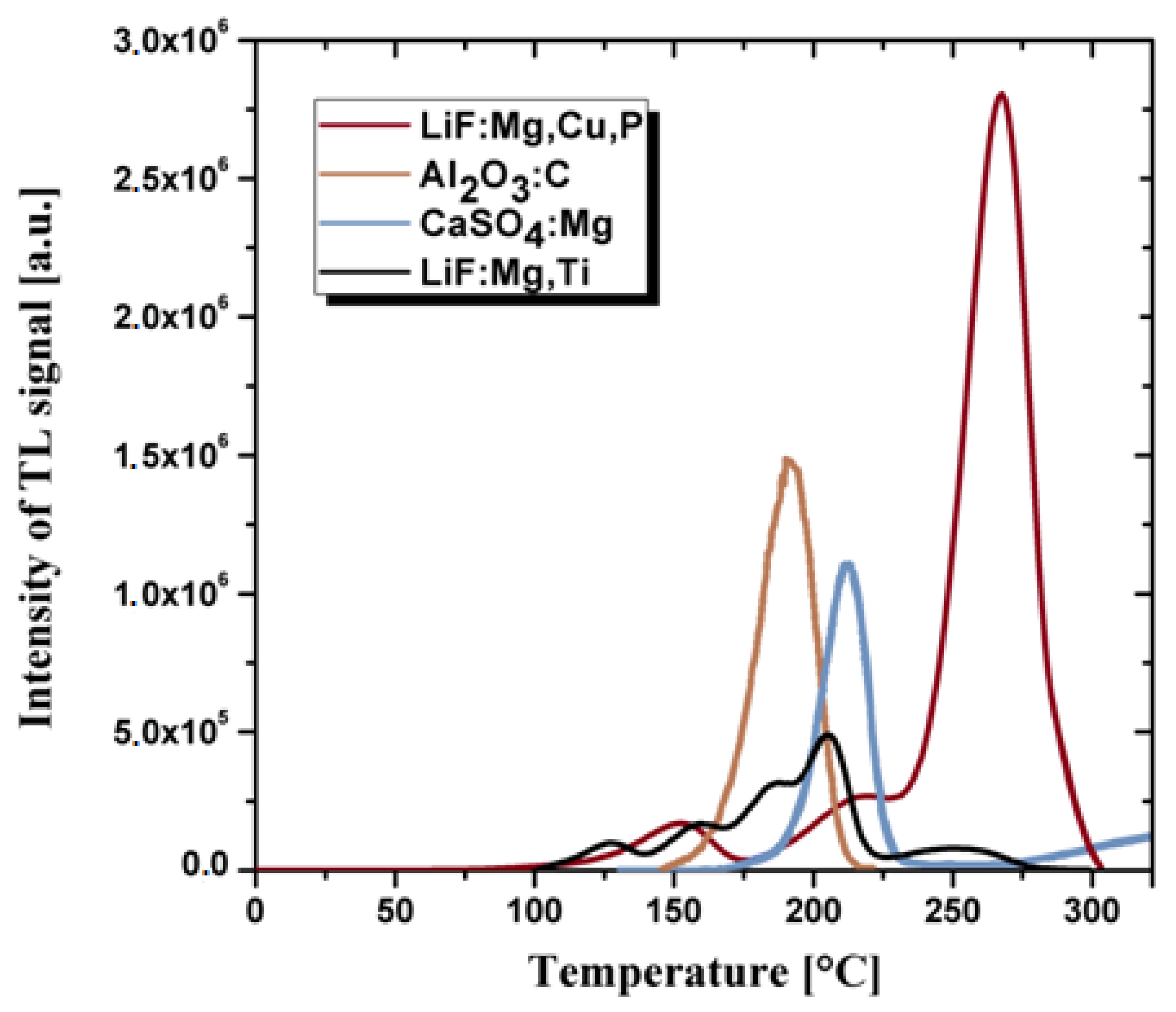
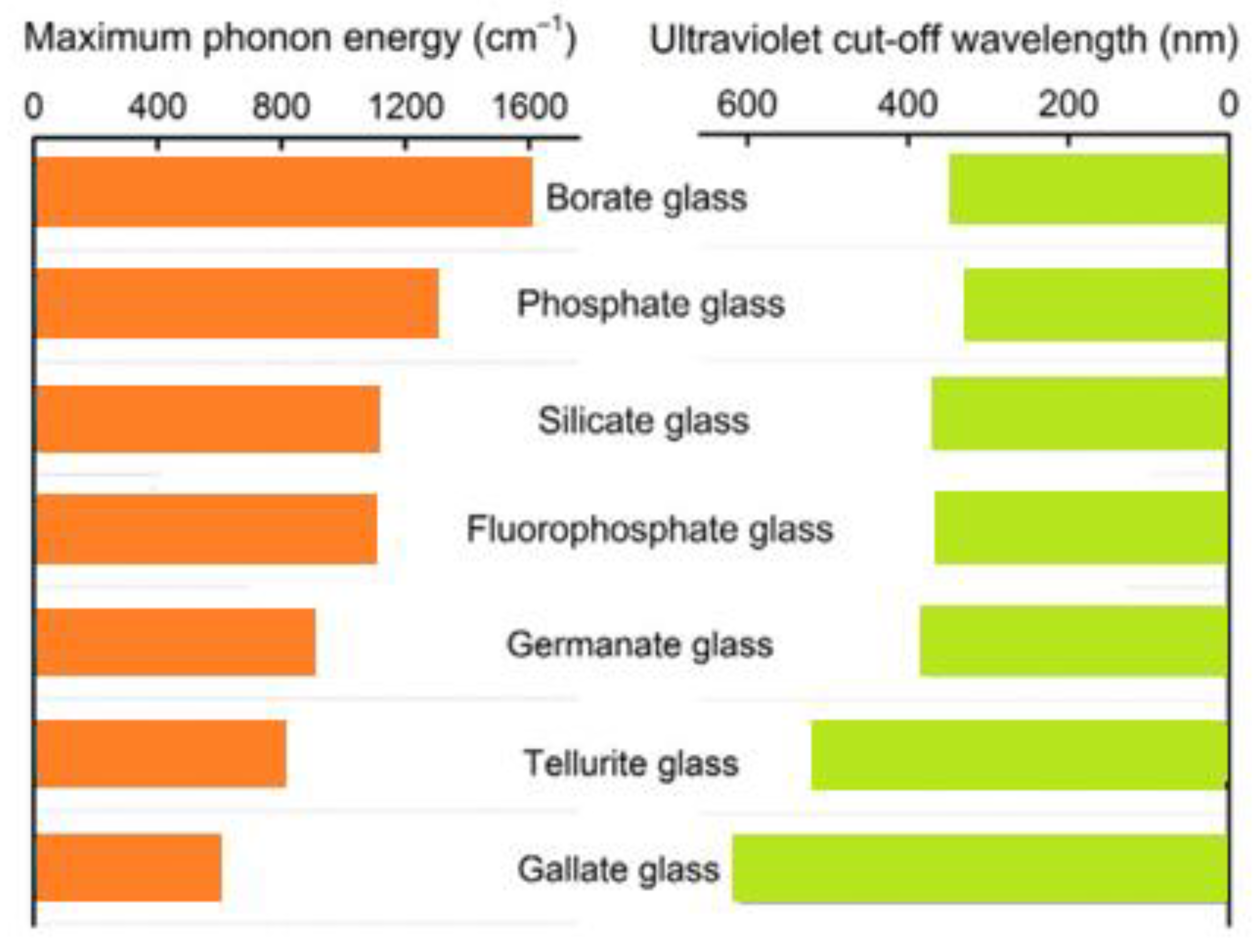
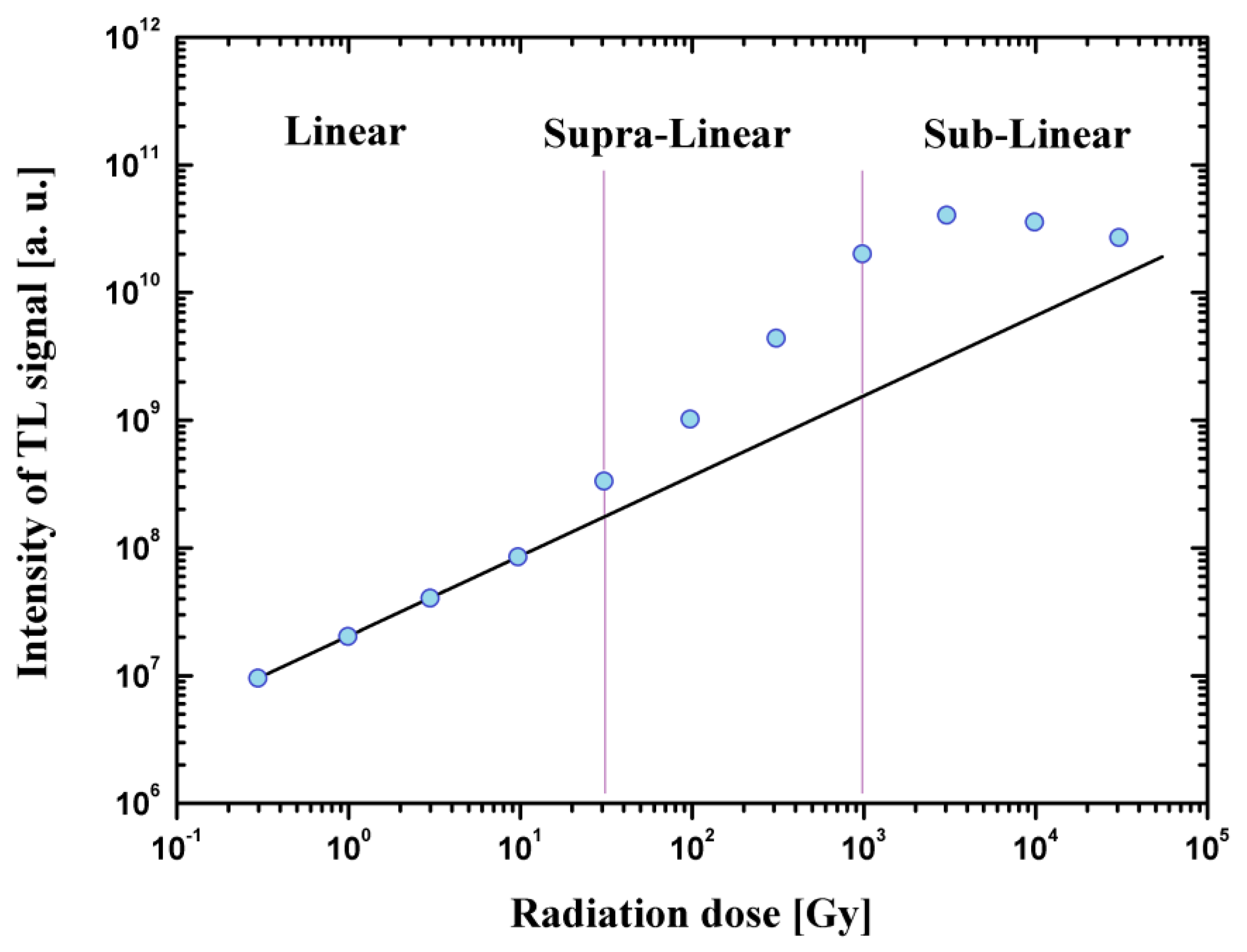
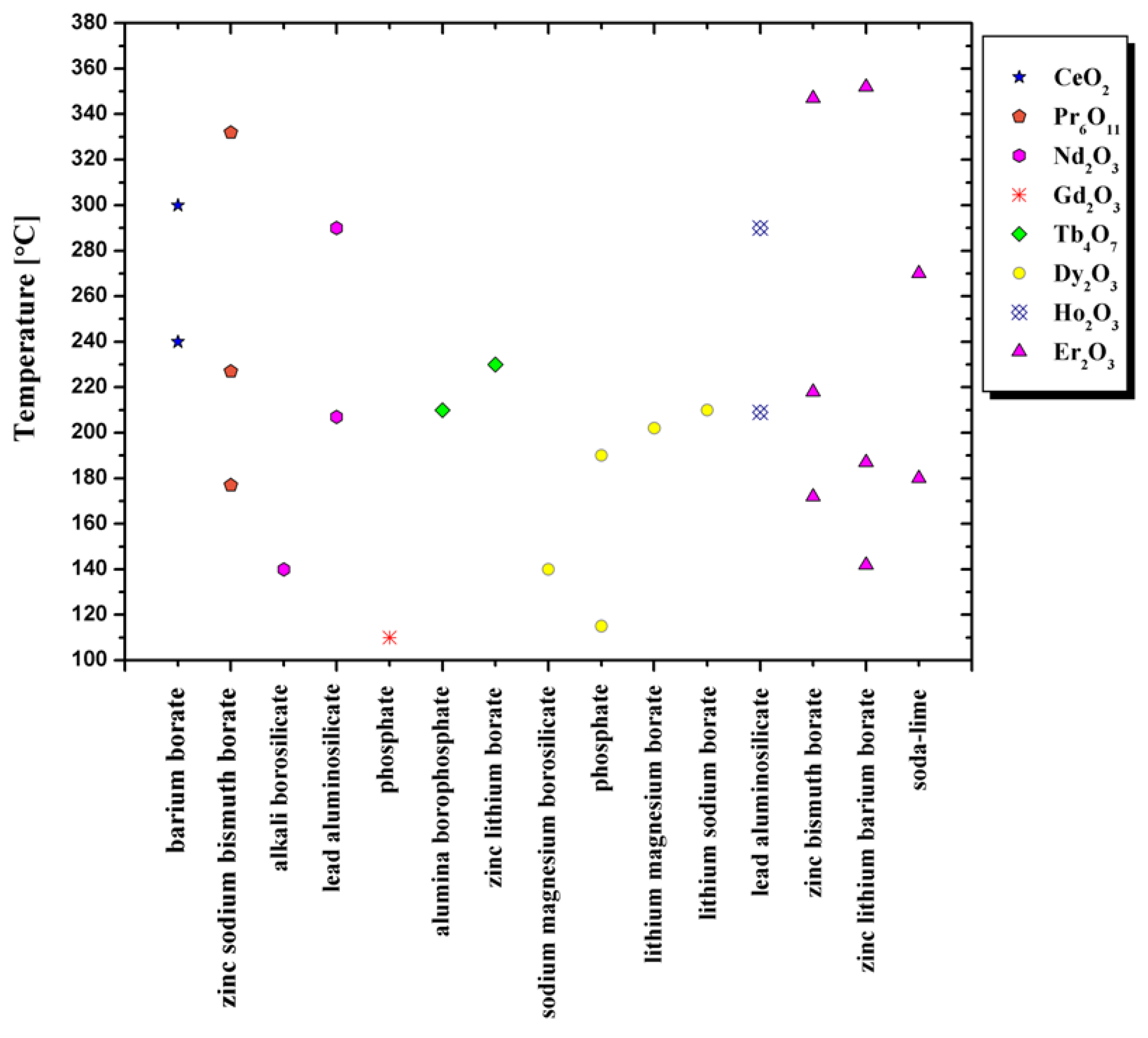
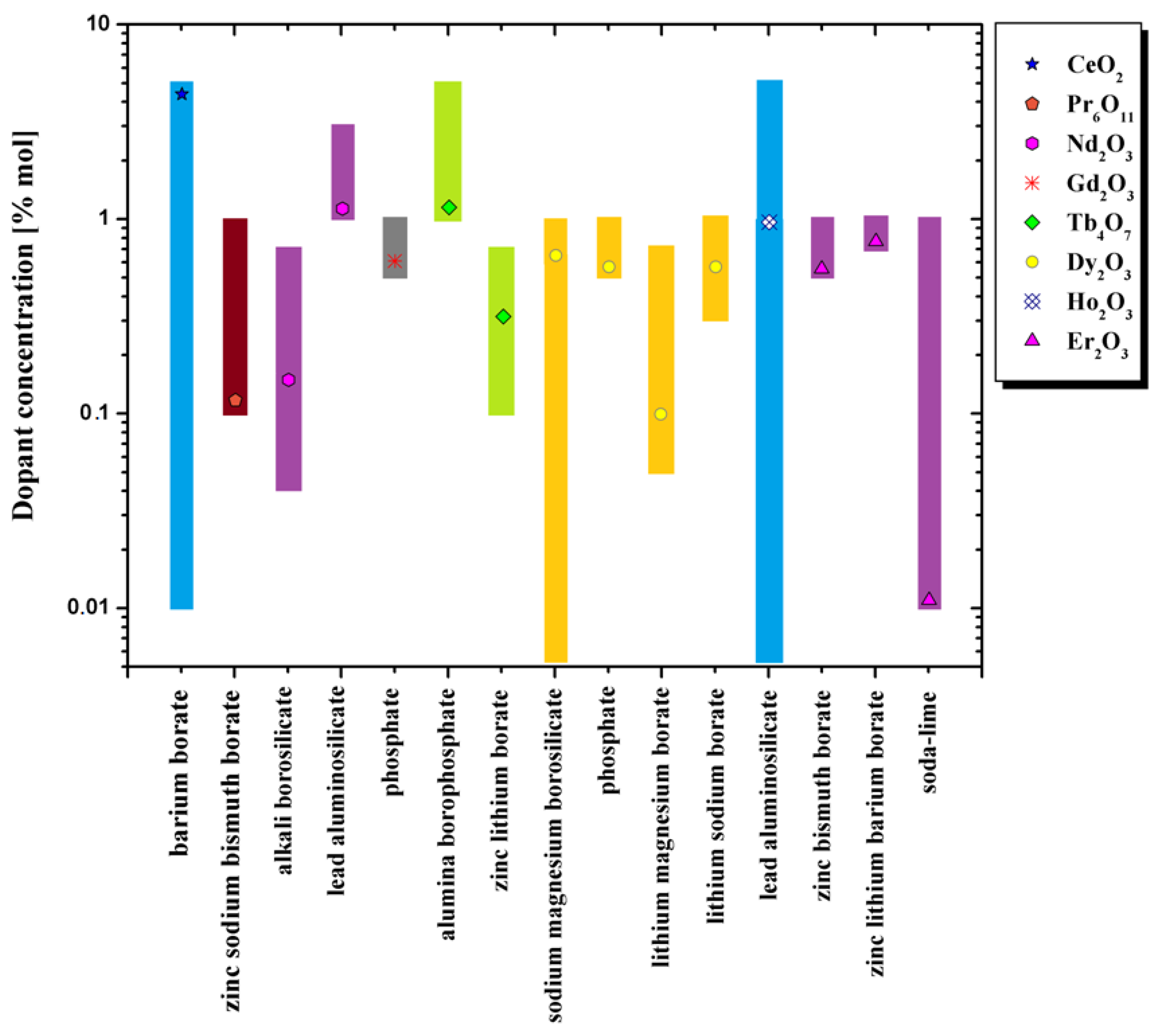
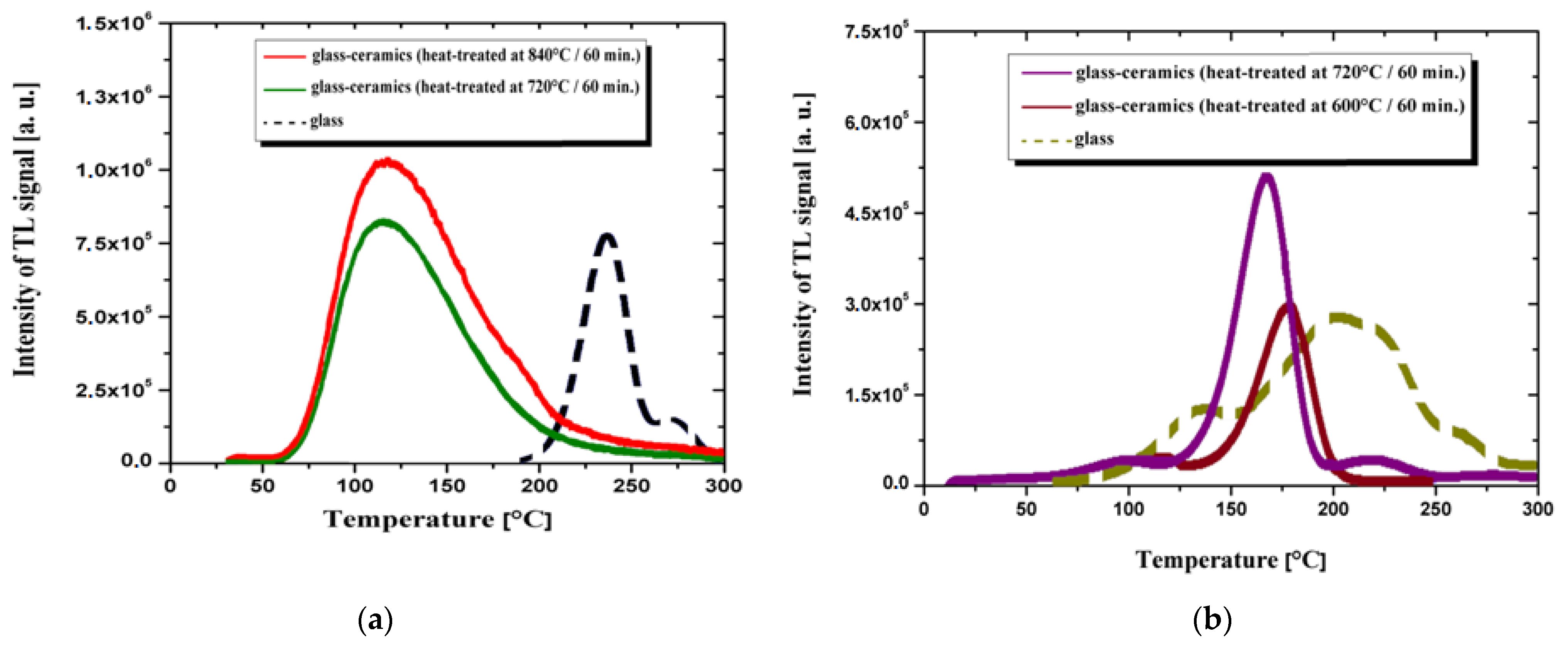
| Glass System | Dopant | Linear Region | References |
|---|---|---|---|
| sodium phosphate | La2O3 | ≤33 Gy | [113] |
| barium borate | CeO2 | ≤10 Gy | [114] |
| zinc sodium bismuth borate | Pr6O11 | ≤3 kGy | [115] |
| alkali borosilicate | Nd2O3 | ≤1 kGy | [116] |
| lead aluminosilicate | Nd2O3 | ≤3 kGy | [117] |
| phosphate | Gd2O3 | ≤10 kGy | [118] |
| alumina borophosphate | Tb2O3 | ≤4 kGy | [119] |
| sodium magnesium borosilicate | Dy2O3 | ≤10 kGy | [120] |
| phosphate | Dy2O3 | ≤10 kGy | [118] |
| lead aluminosilicate | Ho2O3 | ≤5 kGy | [121] |
| zinc bismuth borate | Er2O3 | ≤3 kGy | [122] |
| zinc lithium barium borate | Er2O3 | ≤3 kGy | [123] |
| System | Dopant | Dose | Fading after 7 Days [%] | References |
|---|---|---|---|---|
| sodium phosphate glass | La2O3 | 2 Gy | 35 | [113] |
| alkali borosilicate glass | Nd2O3 | 10 kGy | 22 | [116] |
| zinc lithium borate glass | Tb4O7 | 3 Gy | 11 | [48] |
| lithium magnesium borate glass | Dy2O3 | 5 Gy | 22 | [134] |
| lithium sodium borate glass | Dy2O3 | 3 Gy | 7 | [140] |
| zinc lithium barium borate glass | Er2O3 | 3 kGy | 4 | [123] |
| soda-lime glass | Er2O3 | 14 mGy | 45 | [141] |
| crystalline lithium fluoride | Mg,Cu,P | 10 mGy | <1 | [142] |
| crystalline lithium fluoride | Mg,Ti | 10 mGy | <5 | [142] |
| TL Materials | Peak Intensity of TL Signal [×106] | Temperature of TL Peak [°C] |
|---|---|---|
| LiF:Mg,Cu,P [38] | 2.79 | 265 |
| Al2O3:C [40] | 1.48 | 180 |
| CaSO4:Mg [41] | 1.12 | 215 |
| LiF:Mg,Ti [38] | 0.51 | 205 |
| CeO2-BaO-B2O3 glass-ceramics (treated at 840 °C) [114] | 1.05 | 120 |
| CeO2-BaO-B2O3 glass-ceramics (treated at 720 °C) [114] | 0.78 | 120 |
| CeO2-BaO-B2O3 glass [114] | 0.76 | 235 |
| LiF-B2O3-SiO2 glass-ceramics (treated at 720 °C) [51] | 0.52 | 160 |
| LiF-B2O3-SiO2 glass-ceramics (treated at 600 °C) [51] | 0.29 | 175 |
| LiF-B2O3-SiO2 glass [51] | 0.28 | 200 |
Publisher’s Note: MDPI stays neutral with regard to jurisdictional claims in published maps and institutional affiliations. |
© 2021 by the authors. Licensee MDPI, Basel, Switzerland. This article is an open access article distributed under the terms and conditions of the Creative Commons Attribution (CC BY) license (https://creativecommons.org/licenses/by/4.0/).
Share and Cite
Świontek, S.; Środa, M.; Gieszczyk, W. Ceramics, Glass and Glass-Ceramics for Personal Radiation Detectors. Materials 2021, 14, 5987. https://doi.org/10.3390/ma14205987
Świontek S, Środa M, Gieszczyk W. Ceramics, Glass and Glass-Ceramics for Personal Radiation Detectors. Materials. 2021; 14(20):5987. https://doi.org/10.3390/ma14205987
Chicago/Turabian StyleŚwiontek, Szymon, Marcin Środa, and Wojciech Gieszczyk. 2021. "Ceramics, Glass and Glass-Ceramics for Personal Radiation Detectors" Materials 14, no. 20: 5987. https://doi.org/10.3390/ma14205987
APA StyleŚwiontek, S., Środa, M., & Gieszczyk, W. (2021). Ceramics, Glass and Glass-Ceramics for Personal Radiation Detectors. Materials, 14(20), 5987. https://doi.org/10.3390/ma14205987








